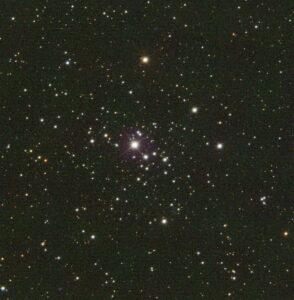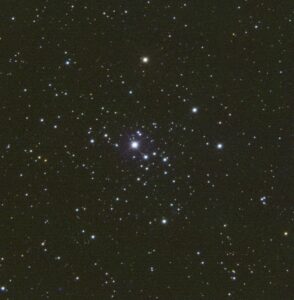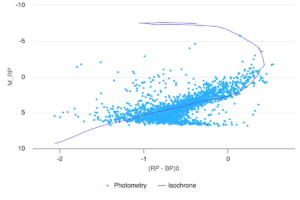NGC 2414 a young cluster approximately 9.5 million years old, is located in the southern constellation Puppis. This cluster was discovered by William Herschel in 1875 using a telescope measuring 47.5 cm. NGC 2414 is situated 1.3 degrees southwest of the well-known open cluster luminaries M46 and M47.
To analyze NGC 2414 and investigate the relationships between the colors, brightnesses, age, and chemical composition of the cluster as a whole, I collected 15 photos. These were taken using the Prompt6 telescope located on Cerro Tololo in Chile. The total exposure times for the B, V, and R filters were 48.03s, 21.41s, and 16.54s respectively. The parameters were set as follows: Max Sun Elevation was set to -15, Min Target Elevation was set to 30, Max Moon Phase was set to 50, and Min Moon Separation was set to 60. The Exposure Efficiency was set to Generic 16-inch. The observation was conducted 5 times, with at least 1 hour between each session. This resulted in a total of 15 images across all three filters. After collecting the images, I used tri-coloring image processing in Afterglow software to stack, align, and calibrate the images I took. The colored image of NGC 2414 after processing in Afterglow is shown below.

After using the Astromancer cluster, I was able to retrieve the basic results. This was achieved by removing the field stars and performing isochrone matching. The results from the analysis of NGC 2414 in the Astromancer cluster are listed below.
| RA | DEC |
Proper Motion in RA(mas/yr) |
Proper Motion in Dec(mas/yr) |
Distance(KPC) | log(Age(yrs)) | Metallicity(solar) | E(B-V) |
| 113.29 | -15.45 | -1.39 | 1.35 | 2.61 | 7.05 | -1.95 | 0.62 |

After obtaining the value of E(B-V) obtained from the isochrone matching. I Used that value to obtain de-reddened image from Afterglow of NGC 2414 below:


When I plotted the Gaia data using the same parameters, I found that all the parameters were almost same. However, the distance and age were slightly greater than my measurements. After comparing both HR diagrams, it appears that the MWSC data forms a more accurate line due to its slightly older age.
Overall the experience of doing this project was amazing. Eventually got an opportunity to learn so many things and the most interesting part was to color the images of the star cluster.
References:-
https://az.wikipedia.org/wiki/NGC_2414
NGC2414 (Open cluster) – In-The-Sky.org
https://astronomynow.com/2024/02/26/explore-puppis-messier-cluster-trio/
https://astronomicon.skynet.unc.edu/clusters/SASC/1018/revisions/35